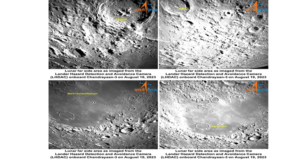 Bangalore: The Chandrayaan-3 lunar mission has embarked on a crucial phase, initiating the meticulous process of identifying a secure landing area on the moon’s surface. This intricate task is being undertaken with the aid of the Lander Hazard Detection and Avoidance Camera (LHDAC), a pioneering technology designed to ensure a smooth and safe landing.
Bangalore: The Chandrayaan-3 lunar mission has embarked on a crucial phase, initiating the meticulous process of identifying a secure landing area on the moon’s surface. This intricate task is being undertaken with the aid of the Lander Hazard Detection and Avoidance Camera (LHDAC), a pioneering technology designed to ensure a smooth and safe landing.
In a significant development, the Indian Space Research Organisation (ISRO) unveiled images captured by the LHDAC, showcasing the lunar far side region. These images will play a pivotal role in pinpointing an appropriate landing site devoid of obstacles such as boulders and deep trenches, thereby ensuring a safe touchdown.
The LHDAC, a specialized instrument that underscores India’s technological prowess, is the brainchild of the Space Applications Centre (SAC), situated in Ahmedabad. SAC, a prominent research and development hub within the ISRO ecosystem, has played a key role in devising this cutting-edge camera system.
As per ISRO’s announcement, the Chandrayaan-3 mission is anticipated to execute its landing sequence at approximately 6:04 PM on Wednesday, August 23. The mission’s overarching objective is to safely and precisely land the Lander Module along with its rover payload on the lunar surface.
The Chandrayaan-3 endeavour was set into motion on July 14, marking another chapter in India’s pursuit of advanced space exploration. With the utilization of groundbreaking technologies like the LHDAC, the mission seeks to expand our understanding of the moon’s composition and geological characteristics.



